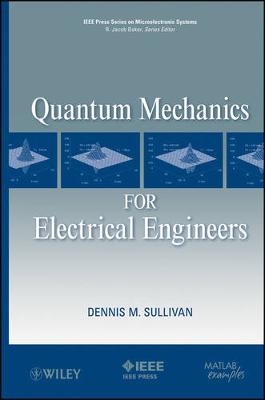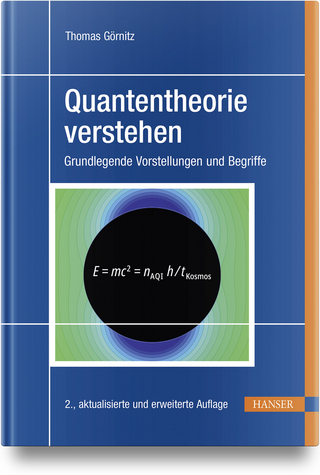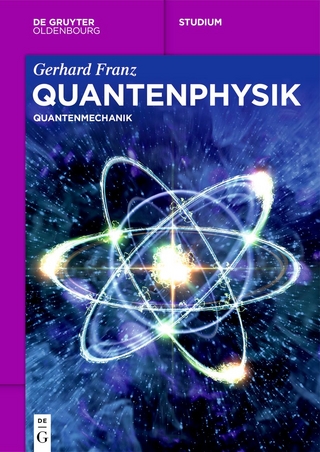
Quantum Mechanics for Electrical Engineers
Wiley-IEEE Press (Verlag)
9780470874097 (ISBN)
DENNIS M. SULLIVAN is Professor of Electrical and Computer Engineering at the University of Idaho as well as an award-winning author and researcher. In 1997, Dr. Sullivan's paper "Z Transform Theory and FDTD Method" won the IEEE Antennas and Propagation Society's R. P. W. King Award for the Best Paper by a Young Investigator. He is the author of Electromagnetic Simulation Using the FDTD Method.
Preface xiii
Acknowledgments xv
About the Author xvii
1. Introduction 1
1.1 Why Quantum Mechanics? 1
1.1.1 Photoelectric Effect 1
1.1.2 Wave–Particle Duality 2
1.1.3 Energy Equations 3
1.1.4 The Schrödinger Equation 5
1.2 Simulation of the One-Dimensional Time-Dependent Schrödinger Equation 7
1.2.1 Propagation of a Particle in Free Space 8
1.2.2 Propagation of a Particle Interacting with a Potential 11
1.3 Physical Parameters: The Observables 14
1.4 The Potential V(x) 17
1.4.1 The Conduction Band of a Semiconductor 17
1.4.2 A Particle in an Electric Field 17
1.5 Propagating through Potential Barriers 20
1.6 Summary 23
Exercises 24
References 25
2. Stationary States 27
2.1 The Infinite Well 28
2.1.1 Eigenstates and Eigenenergies 30
2.1.2 Quantization 33
2.2 Eigenfunction Decomposition 34
2.3 Periodic Boundary Conditions 38
2.4 Eigenfunctions for Arbitrarily Shaped Potentials 39
2.5 Coupled Wells 41
2.6 Bra-ket Notation 44
2.7 Summary 47
Exercises 47
References 49
3. Fourier Theory in Quantum Mechanics 51
3.1 The Fourier Transform 51
3.2 Fourier Analysis and Available States 55
3.3 Uncertainty 59
3.4 Transmission via FFT 62
3.5 Summary 66
Exercises 67
References 69
4. Matrix Algebra in Quantum Mechanics 71
4.1 Vector and Matrix Representation 71
4.1.1 State Variables as Vectors 71
4.1.2 Operators as Matrices 73
4.2 Matrix Representation of the Hamiltonian 76
4.2.1 Finding the Eigenvalues and Eigenvectors of a Matrix 77
4.2.2 A Well with Periodic Boundary Conditions 77
4.2.3 The Harmonic Oscillator 80
4.3 The Eigenspace Representation 81
4.4 Formalism 83
4.4.1 Hermitian Operators 83
4.4.2 Function Spaces 84
Appendix: Review of Matrix Algebra 85
Exercises 88
References 90
5. A Brief Introduction to Statistical Mechanics 91
5.1 Density of States 91
5.1.1 One-Dimensional Density of States 92
5.1.2 Two-Dimensional Density of States 94
5.1.3 Three-Dimensional Density of States 96
5.1.4 The Density of States in the Conduction Band of a Semiconductor 97
5.2 Probability Distributions 98
5.2.1 Fermions versus Classical Particles 98
5.2.2 Probability Distributions as a Function of Energy 99
5.2.3 Distribution of Fermion Balls 101
5.2.4 Particles in the One-Dimensional Infinite Well 105
5.2.5 Boltzmann Approximation 106
5.3 The Equilibrium Distribution of Electrons and Holes 107
5.4 The Electron Density and the Density Matrix 110
5.4.1 The Density Matrix 111
Exercises 113
References 114
6. Bands and Subbands 115
6.1 Bands in Semiconductors 115
6.2 The Effective Mass 118
6.3 Modes (Subbands) in Quantum Structures 123
Exercises 128
References 129
7. The Schrödinger Equation for Spin-1/2 Fermions 131
7.1 Spin in Fermions 131
7.1.1 Spinors in Three Dimensions 132
7.1.2 The Pauli Spin Matrices 135
7.1.3 Simulation of Spin 136
7.2 An Electron in a Magnetic Field 142
7.3 A Charged Particle Moving in Combined E and B Fields 146
7.4 The Hartree–Fock Approximation 148
7.4.1 The Hartree Term 148
7.4.2 The Fock Term 153
Exercises 155
References 157
8. The Green’s Function Formulation 159
8.1 Introduction 160
8.2 The Density Matrix and the Spectral Matrix 161
8.3 The Matrix Version of the Green’s Function 164
8.3.1 Eigenfunction Representation of Green’s Function 165
8.3.2 Real Space Representation of Green’s Function 167
8.4 The Self-Energy Matrix 169
8.4.1 An Electric Field across the Channel 174
8.4.2 A Short Discussion on Contacts 175
Exercises 176
References 176
9. Transmission 177
9.1 The Single-Energy Channel 177
9.2 Current Flow 179
9.3 The Transmission Matrix 181
9.3.1 Flow into the Channel 183
9.3.2 Flow out of the Channel 184
9.3.3 Transmission 185
9.3.4 Determining Current Flow 186
9.4 Conductance 189
9.5 Büttiker Probes 191
9.6 A Simulation Example 194
Exercises 196
References 197
10. Approximation Methods 199
10.1 The Variational Method 199
10.2 Nondegenerate Perturbation Theory 202
10.2.1 First-Order Corrections 203
10.2.2 Second-Order Corrections 206
10.3 Degenerate Perturbation Theory 206
10.4 Time-Dependent Perturbation Theory 209
10.4.1 An Electric Field Added to an Infinite Well 212
10.4.2 Sinusoidal Perturbations 213
10.4.3 Absorption, Emission, and Stimulated Emission 215
10.4.4 Calculation of Sinusoidal Perturbations Using Fourier Theory 216
10.4.5 Fermi’s Golden Rule 221
Exercises 223
References 225
11. The Harmonic Oscillator 227
11.1 The Harmonic Oscillator in One Dimension 227
11.1.1 Illustration of the Harmonic Oscillator Eigenfunctions 232
11.1.2 Compatible Observables 233
11.2 The Coherent State of the Harmonic Oscillator 233
11.2.1 The Superposition of Two Eigentates in an Infinite Well 234
11.2.2 The Superposition of Four Eigenstates in a Harmonic Oscillator 235
11.2.3 The Coherent State 236
11.3 The Two-Dimensional Harmonic Oscillator 238
11.3.1 The Simulation of a Quantum Dot 238
Exercises 244
References 244
12. Finding Eigenfunctions Using Time-Domain Simulation 245
12.1 Finding the Eigenenergies and Eigenfunctions in One Dimension 245
12.1.1 Finding the Eigenfunctions 248
12.2 Finding the Eigenfunctions of Two-Dimensional Structures 249
12.2.1 Finding the Eigenfunctions in an Irregular Structure 252
12.3 Finding a Complete Set of Eigenfunctions 257
Exercises 259
References 259
Appendix A. Important Constants and Units 261
Appendix B. Fourier Analysis and the Fast Fourier Transform (FFT) 265
B.1 The Structure of the FFT 265
B.2 Windowing 267
B.3 FFT of the State Variable 270
Exercises 271
References 271
Appendix C. An Introduction to the Green’s Function Method 273
C.1 A One-Dimensional Electromagnetic Cavity 275
Exercises 279
References 279
Appendix D. Listings of the Programs Used in this Book 281
D.1 Chapter 1 281
D.2 Chapter 2 284
D.3 Chapter 3 295
D.4 Chapter 4 309
D.5 Chapter 5 312
D.6 Chapter 6 314
D.7 Chapter 7 323
D.8 Chapter 8 336
D.9 Chapter 9 345
D.10 Chapter 10 356
D.11 Chapter 11 378
D.12 Chapter 12 395
D.13 Appendix B 415
Index 419
| Erscheint lt. Verlag | 21.2.2012 |
|---|---|
| Reihe/Serie | IEEE Press Series on Microelectronic Systems |
| Zusatzinfo | Charts: 50 B&W, 0 Color; Photos: 50 B&W, 0 Color; Drawings: 50 B&W, 0 Color |
| Sprache | englisch |
| Maße | 163 x 241 mm |
| Gewicht | 758 g |
| Themenwelt | Naturwissenschaften ► Physik / Astronomie ► Quantenphysik |
| Technik ► Elektrotechnik / Energietechnik | |
| ISBN-13 | 9780470874097 / 9780470874097 |
| Zustand | Neuware |
| Informationen gemäß Produktsicherheitsverordnung (GPSR) | |
| Haben Sie eine Frage zum Produkt? |
aus dem Bereich


